If you haven't read my review of the first book in this series, Breaking Into Japanese Literature, I suggest you go do that now (or don't, I won't be able to tell if you did either way). This is the successor to that book, also by Giles Murray, and it is meant to be the next step for advanced Japanese language learners to read classic literature.
This has all the positives of the last book, plus some of what I consider to be improvements. Not only does it include one of my all time favorite Japanese novels, but it has more contemporary selections compared to its predecessor. And even though it does not contain as many stories, it still has a wider variety of genres. So even if you don't like one story, there should be at least one that interests you.
Heavy Content

This book contains three very famous Japanese novels. Snow Country ( 雪国) by Yasunari Kawabata, Patriotism ( 憂国) by Yukio Mishima, and The Secret ( 秘密) by Jun'ichirō Tanizaki. If you are into Japanese literature already, you probably know these names. If you don't, just trust me on this, these are the authors you are going to want to read. If you take a Japanese literature class you will almost certainly have to read something by each one of these literary giants.
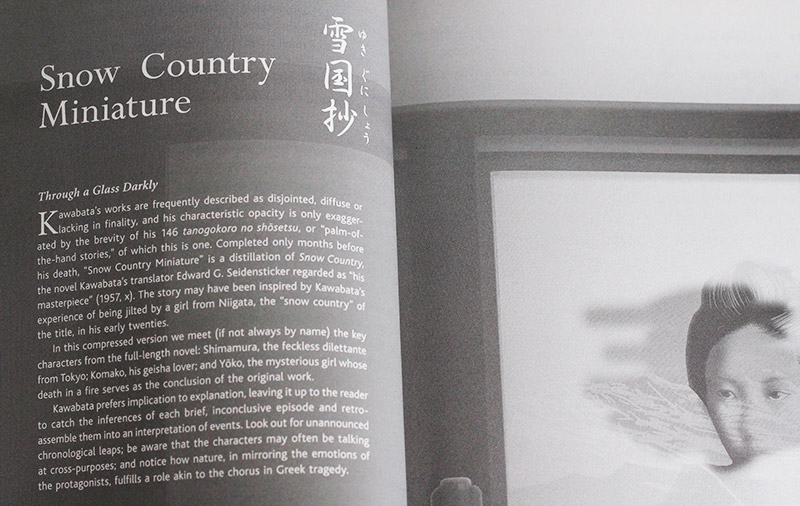
These stories are presented in their entirety, except for Snow Country. It is a "miniature" which is basically a nice way of saying it was really long so they cut it down. It is famous for being written in a very "Japanese" style. What I mean by that is it is very descriptive. When you read it, it is almost like you are reading the text version of a dream. But I am warning you now, the translator gives away the ending in the introduction to this one, so if you do not want it spoiled do not read the intro! (Okay you probably read it by now, but I tried to warn you.)
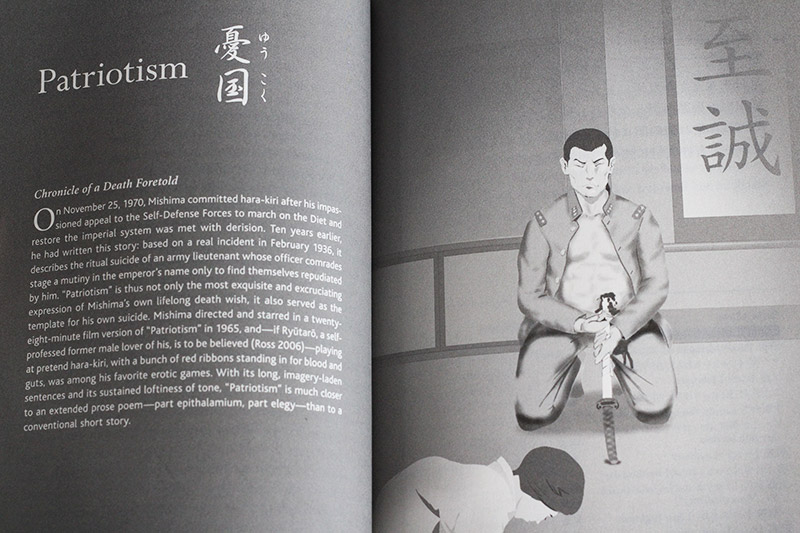
The second story, Patriotism is another classic, but not at all in the same vein as Snow Country. It is heart wrenching, yes, but it is extremely gruesome and the content can be hard for many people to handle. That picture should give you a pretty good idea of what is happening in the story. It expresses the unbelievable loyalty of Japanese soldiers to both their country and the Emperor, and a wife's duty to her husband (during World War II). If you can get through it, you will understand why it was so important for its time. But you have been warned. It is not an easy read, content-wise.
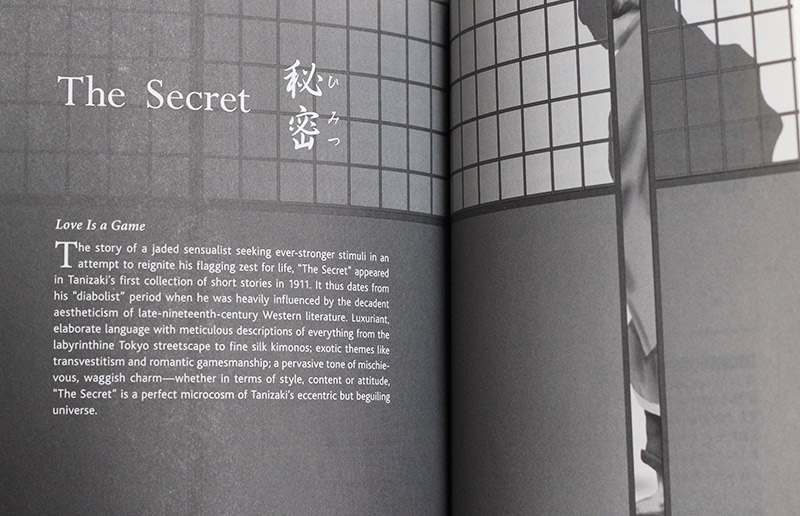
The last story, The Secret, was the only one I had not read before, though I am familiar with Tanizaki (and I am not exactly what you would call a fan). It is the extraordinary journey of a man, dressed as a woman, who rediscovers the streets of Tokyo, followed by his struggle to uncover his secret lover's location through sheer memory of motion.
The biggest thing I am trying to get across is that this selection can help you recognize the various styles of writing literary authors in Japan can convey. When you go from the flowing, dreamy style of Snow County, into the blunt, realistic grief of Patriotism, all the way to the stream of consciousness exploration in The Secret, you should be able to distinguish different styles for what they are. You are past just understanding what they say, you can feel the difference between the texts.
Same Great Layout
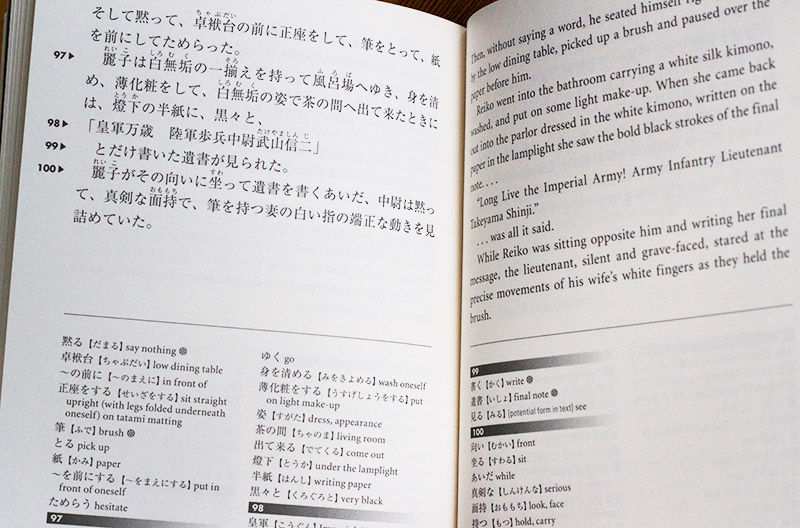
Just like the last book, this has my preferred bilingual book layout. Japanese on the left, English translation on the right, and a follow along dictionary on the bottom half of each page. The more of these books I read through, the more I grow to favor this style above those with dictionaries in the back or Japanese text followed by English on the same page. It is simple, clean, and makes for easy reading. No extra page flipping making my hands tired, and no outside resources required.
The only downside to this is that it is really easy to "cheat." Instead of struggling to figure out the meaning of a sentence yourself, you can just slide your eyes over to the English translation instead. That is not necessarily a bad thing, but it does mean that you may be using this book less for studying and more for the sake of reading (which, again, is not a bad thing). So if you want to use this to study or hone your skills, resist the temptation to peek.
Exploring Japanese Literature - Verdict
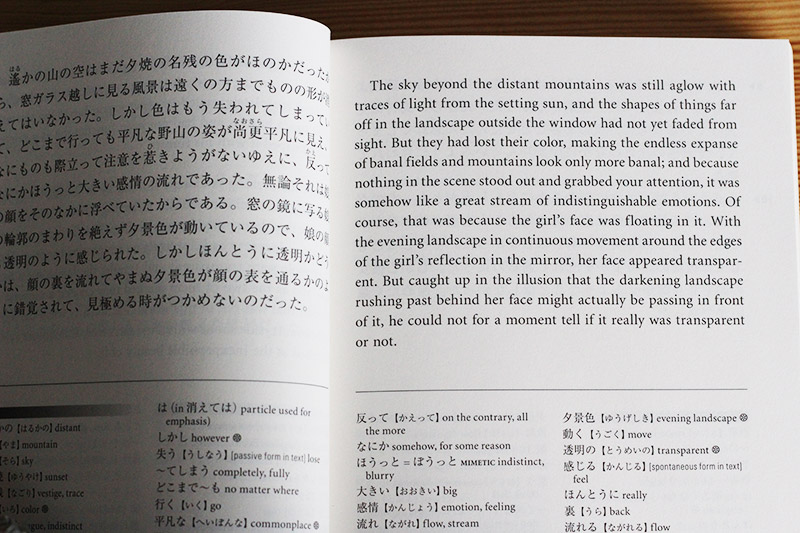
This is everything I like about Breaking Into Japanese Literature but with more enjoyable content. Yes, it is harder in some respects (as if the first one wasn't hard enough, right?). But because it is newer material, the vocabulary was less obscure overall, and the selection was way more up my ally. Anyone who liked the first book will undoubtedly enjoy this one too. And just like the first, even if you do not use it for the Japanese section, it is a nice starter to reading Japanese literature in English. These are big names, important stories, and definitely worth the price.
Kristen’s Review
While the content was a bit dark and some of it seemed dated to me, I think this is an absolute must read if you’re serious about getting into Japanese literature and you need a way in. These three authors are so incredibly important to Japanese history, so missing out on them would be such a waste.
